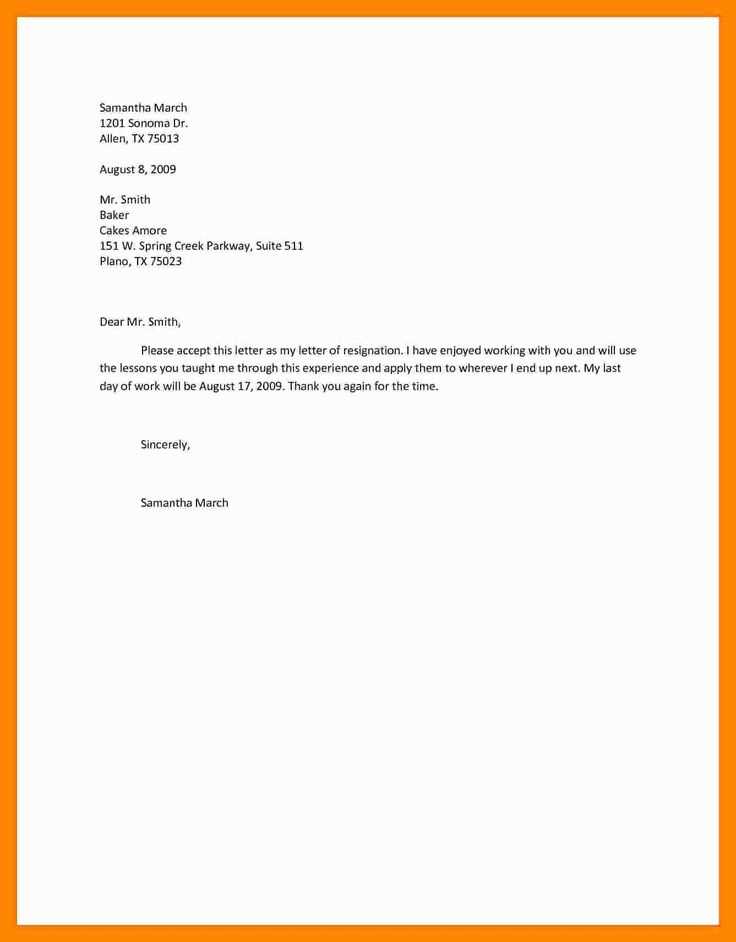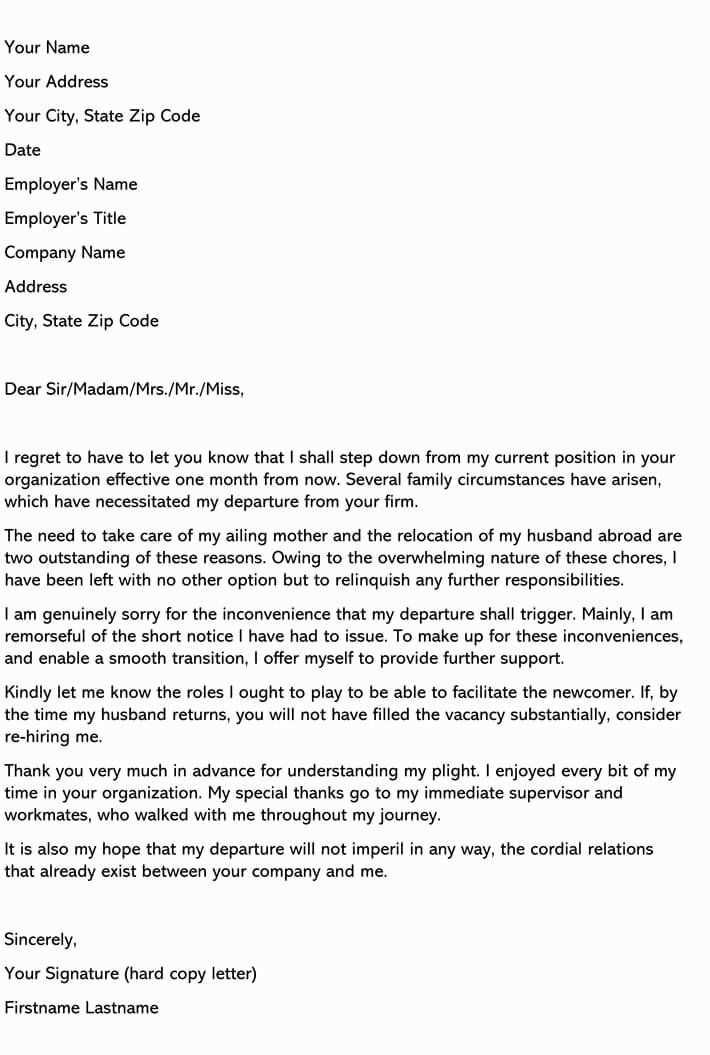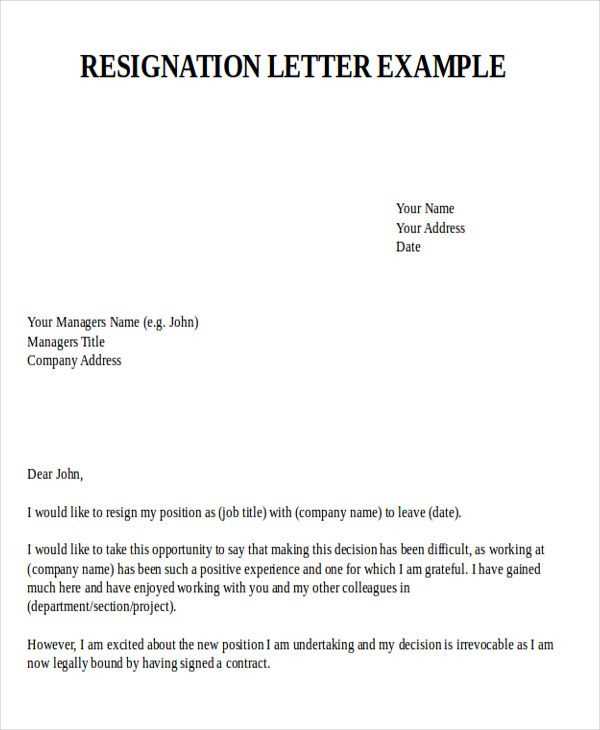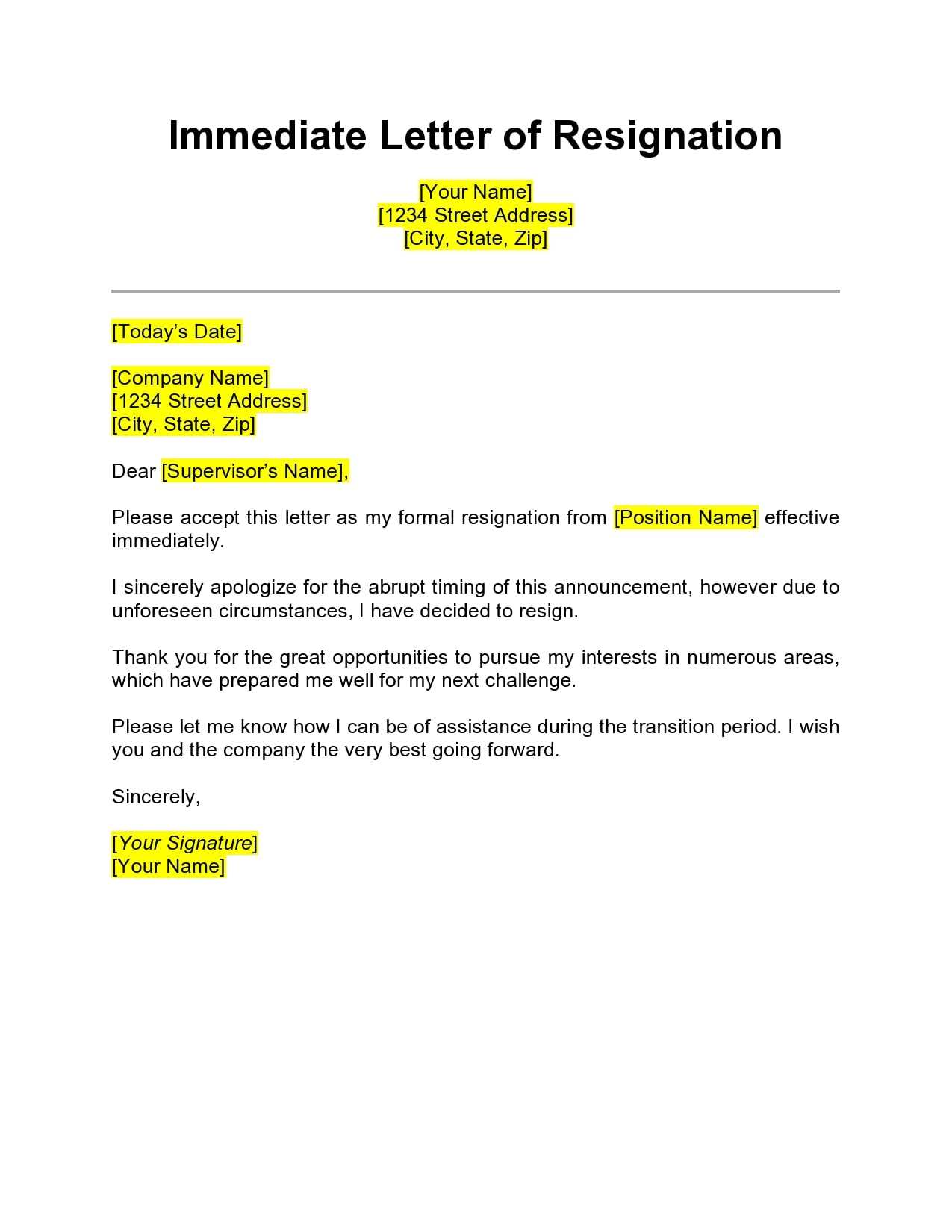htmlEditImmediate Resignation Letter Template for Quick and Professional Resignation

When an individual decides to leave their position unexpectedly, it’s important to communicate this change efficiently and professionally. Crafting a well-structured message ensures clarity and helps maintain a positive relationship with the employer, even when the departure is sudden. This communication serves as a formal notification, outlining the decision to step down from duties immediately.
A well-written notice conveys respect and transparency. Even when faced with personal or professional circumstances that require swift action, delivering this message in a tactful manner can make a significant difference in how the decision is perceived. The key is to keep the message clear, direct, and composed, avoiding unnecessary details while highlighting gratitude for the opportunity provided.
Reasons for Sudden Departure
There are various situations that might prompt an individual to leave their role with little to no notice. Personal issues, health concerns, or an unexpected job opportunity may all play a part in the decision to step away swiftly. Regardless of the reason, it’s important to handle this situation delicately to ensure a smooth transition for both the individual and the employer.
Personal and Family Matters

Family emergencies or personal health concerns are some of the most common reasons for a rapid departure. These situations often require immediate attention, leaving the person with little time to prepare a longer exit process. In such cases, it’s crucial to notify the employer as early as possible, even if the departure happens quickly.
New Job or Career Change
Sometimes, a new professional opportunity arises unexpectedly, and the individual must make a quick decision. These opportunities may offer better career growth, benefits, or compensation, prompting the person to act without delay. In these cases, transparency and a professional tone are essential to ensure both parties remain respectful during the transition.
Understanding the Need for Quick Departure

There are various circumstances in which an individual might find it necessary to leave their job without prior notice or with minimal preparation. These situations can range from personal emergencies to unforeseen professional opportunities that demand immediate action. In such cases, the individual must ensure that their decision is communicated clearly and professionally, despite the urgency.
In some instances, a quick exit is the result of a sudden change in personal circumstances, such as a family emergency or health issues that require immediate attention. In other cases, it could stem from a new career opportunity that presents itself unexpectedly. Regardless of the reason, the need for a prompt departure is often driven by factors beyond the individual’s control, making it crucial to handle the situation with care to minimize any disruption.
How to Structure Your Message
When drafting a formal notice of departure, it is important to follow a clear and concise structure. This ensures that the message is professional and effectively communicates the necessary information to the employer. A well-organized statement not only shows respect for the employer but also helps maintain a positive relationship after the transition.
Start by clearly stating the intention to leave and the effective date, making it apparent from the beginning. Be sure to include a brief explanation of the reason for the sudden exit if appropriate, but avoid going into excessive detail. Express gratitude for the opportunity to work with the organization and offer assistance with the transition process if possible. Finally, close on a positive note, reiterating appreciation and wishing the company continued success.
Essential Elements to Include
When crafting a formal notice of departure, it’s important to include key components that ensure clarity and professionalism. These elements help convey your message effectively and provide the necessary details to your employer in a straightforward manner.
First, you should clearly state your decision to leave, specifying the exact date of your final day. Next, a brief explanation of the reason for your swift exit can be included, though it’s not mandatory. It’s essential to express your gratitude for the opportunity to work with the company and acknowledge the positive experiences gained during your time there. Additionally, offering your assistance in the transition process can demonstrate your commitment to making the change as smooth as possible. Lastly, a polite closing expressing your best wishes for the organization’s future success can help maintain a professional and respectful tone.
Professional Tone in Departure Notification
Maintaining a professional tone is crucial when informing an employer about your decision to leave. Whether the departure is planned or sudden, the manner in which the information is communicated can leave a lasting impression. A respectful, courteous approach helps ensure that your professional reputation remains intact and that the transition is as smooth as possible.
Respect and Courtesy
Regardless of the circumstances surrounding your departure, it’s essential to remain respectful. Acknowledge the experiences and opportunities you’ve gained while working with the company. This will convey your appreciation and leave the door open for future professional relationships.
Clarity and Directness
While maintaining a polite tone, it’s also important to be clear and direct about your decision. Avoid vague language or excessive explanations. Keep the message concise and focused on the essential details, such as the date of departure and your willingness to assist during the transition. This shows professionalism and helps your employer plan accordingly.
Maintaining Courtesy and Respect
Regardless of the circumstances prompting your departure, maintaining a respectful and courteous tone is essential in preserving professional relationships. A graceful exit ensures that both parties leave the situation on good terms and demonstrates maturity and professionalism. The way you communicate your decision can have a significant impact on how you’re remembered by colleagues and supervisors.
How to Show Respect in Your Message
- Express gratitude for the opportunities provided during your time with the company.
- Acknowledge positive experiences that have shaped your professional development.
- Offer assistance in the transition process, showing that you care about the company’s well-being even after your departure.
Maintaining Professionalism After Departure
- Refrain from criticizing the organization or any individuals involved, regardless of your reasons for leaving.
- Keep any future communication polite and focused on professional matters.
- Respect the confidentiality of the company’s information, even after you’ve left your role.
Addressing the Right Person
When preparing your departure communication, it’s important to ensure that you are addressing the right individual within the organization. This will help ensure that your message is received by the appropriate person who can process and manage the necessary steps for your exit. Incorrectly addressing the message could delay or complicate the process, making it more difficult for both you and your employer.
Identifying the Correct Recipient
Typically, the person to address is either your direct supervisor, manager, or the HR department, depending on company protocol. Understanding the hierarchy and communication structure within the organization will help you determine the best course of action for ensuring your message reaches the right individual.
Common Roles to Address
| Role | Responsibility |
|---|---|
| Direct Supervisor | Primary person to notify if you are leaving your current position. Often responsible for facilitating the transition. |
| HR Department | Handles administrative aspects of your departure, such as benefits, final paycheck, and paperwork. |
| Manager/Department Head | Oversees your team or department and may need to manage resources or reassign duties after your departure. |
Directing Your Departure to the Appropriate Authority
When deciding to leave your position, it is essential to ensure that your communication reaches the right authority within the organization. This ensures a smooth transition and avoids unnecessary delays in processing your departure. Directing your message to the appropriate person or department helps maintain professionalism and allows the company to take the necessary actions quickly and efficiently.
Key Steps to Identify the Right Contact
- Review your company’s hierarchy: Determine who is responsible for managing exits and transitions in your department or team.
- Consult company policies: Check whether there is a formal procedure for notifying the organization of your decision to leave.
- Consider your direct supervisor: If possible, notify your immediate manager or supervisor first, as they will be directly affected by your departure.
Common Authorities to Address

- Human Resources Department – Handles all administrative aspects of your departure, including benefits and final paperwork.
- Direct Supervisor or Manager – Manages your day-to-day responsibilities and is typically the first person to be informed.
- Upper Management – In cases where your role impacts higher-level decisions or requires approval from senior leadership, they may also need to be notified.